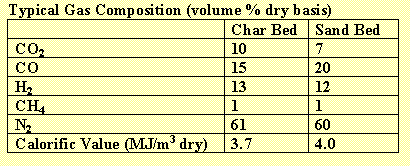|
|
|||||||||||||||||||||||
|
Chemical and Process Engineering |
|||||||||||||||||||||||
|
|
|||||||||||||||||||||||
|
|
|
|
|
|
|
||||||||||||||||||
|
A S Jessup-Bould: Fluidised Bed Coal
Gasification |
|||||||||||||||||||||||
|
|
|
|
|
|
|
||||||||||||||||||
|
|
|
|
|
|
|
||||||||||||||||||
|
OSC
Process Engineering Limited (my employer at the time) were
licensed to market the British Coal industrial fluidised bed gasifier. This was a low pressure spouted bed design
based on the 12 tonnes coal throughput per day, semi-full scale, pilot unit
at the Coal Research Establishment (CRE) at Stoke Orchard near Cheltenham.
The technology was aimed at industries requiring significant amounts of fuel
gas such as industrial furnaces or kilns. OSC
offered a series of standard design sizes up to 2 metres diameter which would
be fuelled by coal and could be run as char or inert beds. Oxygen enrichment
of the fluidising air was also available in cases where a higher calorific
value gas was required. During my period of employment with OSC I was
responsible for assessing which units and mode of operation would be most
suitable for a clients needs, taking into account
the feedstocks available. In some cases CRE
performed bench scale pilot tests to predict performance using different feedstocks. Some enquiries were for budget prices and required
a low level of technical involvement. For other more serious enquiries I was
required to produce more detailed schemes, for which I prepared process flow
diagrams, heat and mass balances, utility requirements etc
based upon one or sometimes more of the standard sized units. Part of my
work included revising the standard OSC design based on the results of trials
carried out at CRE. The process design work which I completed included
P&IDs, equipment process data sheets and instrument data sheets. |
|
||||||||||||||||||||||
|
|
|
|
|
||||||||||||||||||||
|
|
|
|
|||||||||||||||||||||
|
Process
Description |
|
|
|||||||||||||||||||||
|
|
|
|
|||||||||||||||||||||
|
Industrial
grade coal (12 to 25 mm) is fed overbed via two
lock hoppers into the fluidised bed gasifier.
Fluidisation is achieved by forcing a mixture of air and steam through the
bed. The air and steam react with the coal to produce the fuel gas having a
typical composition as shown in the table below. Limestone
is used to absorb sulphur which would otherwise be present in the fuel gas. The gasifier is operated at around 980°C with a fluidising
velocity of between 1.5 and 2.0 m/s. Hot fines carried out of the gasifier in the fuel gas stream are separated in a
cyclone and re-injected back in to the gasifier to
increase the carbon utililisation efficiency of the
process. A small
amount of bed material is removed to prevent the accumulation of mineral
matter. The hot
gases leaving the cyclone are cooled to reduce their volume and to raise
steam for use in the gasification process. Excess steam can be utilised on
the industrial plant where the gasifier is to be
located. Cooled gases can be filtered or scrubbed to remove any residual particles from the gas before it is used. |
|||||||||||||||||||||||
|
|
|
|
|
|
|
||||||||||||||||||
|
|
|||||||||||||||||||||||
|
|
|
|
|
|
|
||||||||||||||||||
|
|
|||||||||||||||||||||||
|
|
|
|
|
|
|
||||||||||||||||||
|
Unit Operations Fluidised Bed Gasification (Char & Bauxite bed). Fans. Cyclones. Steam raising system. Power generation (Gas engine). Bag filtration. Dense & lean phase solids conveying. Solids cooling & mechanical conveying. Materials of Construction Steels; carbon, stainless, hardened, lined. Refractory brickwork. Documents Produced PFDs & mass balances. P&IDs. Process & instrument data sheets. |
Hazards Fuels (producer gas; explosive / toxic). Dusts containing heavy metals. Hot surfaces and materials (eg Char). Liaison Technology provider. Other engineering disciplines. Drawing office. Sales and proposals departments. Estimating department. Clients. Commissioning engineers. Suppliers. |
||||||||||||||||||||||
|
|
|
|
|||||||||||||||||||||
|
|
|
|
|
|
|
|
|
|
|
|
|
|
|
|
|||||||||

